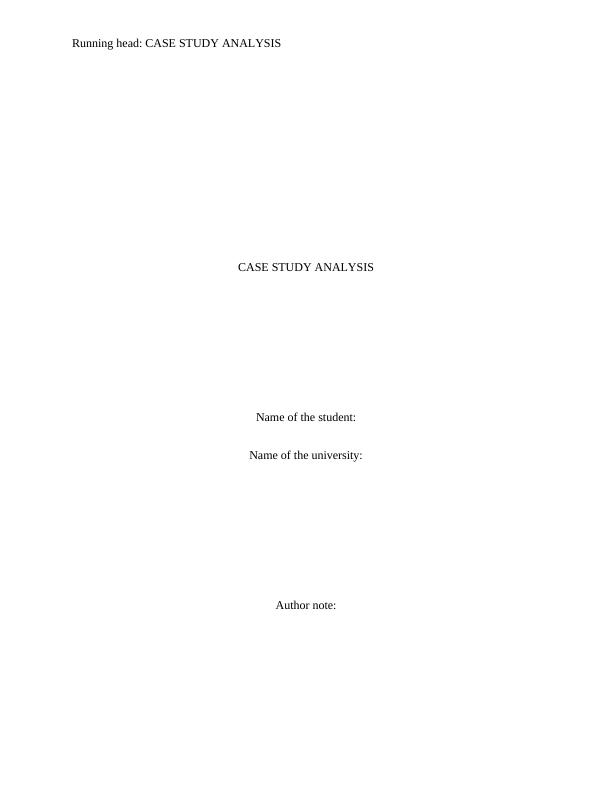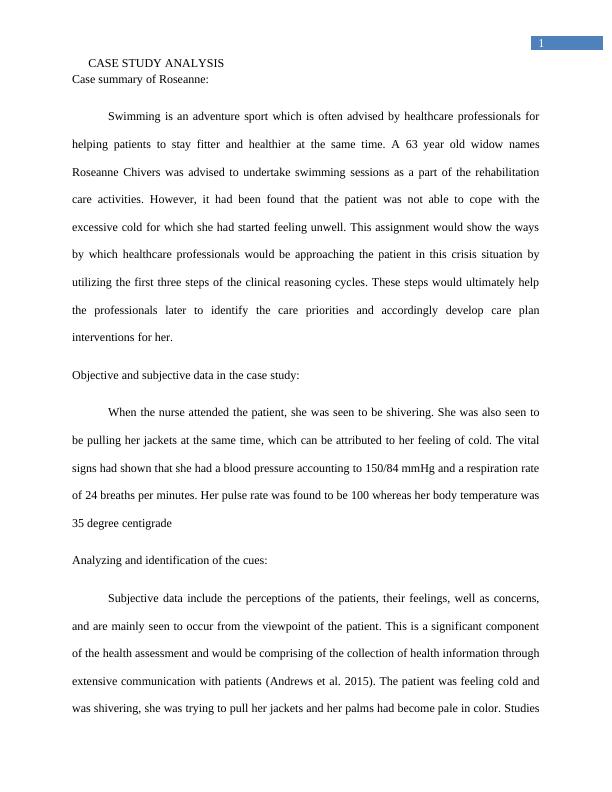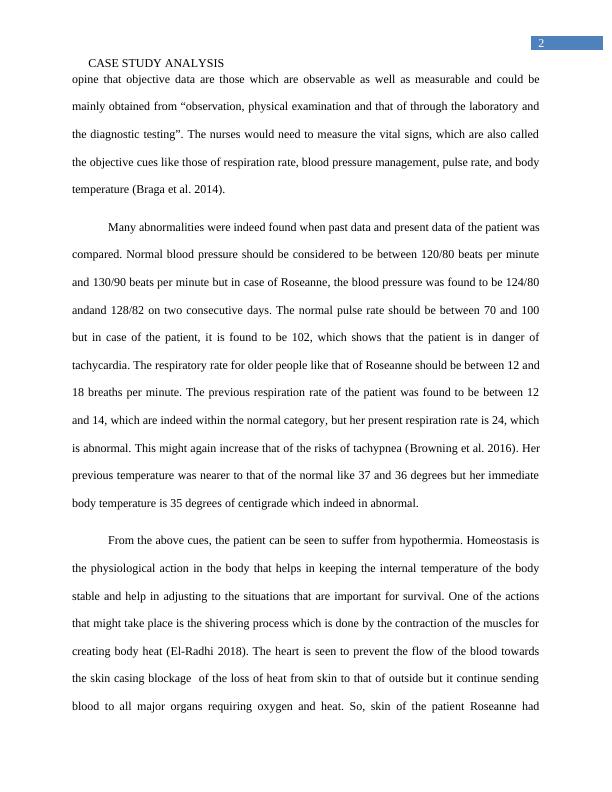Case Study Analysis: Roseanne's Hypothermia Crisis
Added on 2023-01-04
7 Pages1828 Words97 Views
Running head: CASE STUDY ANALYSIS
CASE STUDY ANALYSIS
Name of the student:
Name of the university:
Author note:
CASE STUDY ANALYSIS
Name of the student:
Name of the university:
Author note:

1
CASE STUDY ANALYSIS
Case summary of Roseanne:
Swimming is an adventure sport which is often advised by healthcare professionals for
helping patients to stay fitter and healthier at the same time. A 63 year old widow names
Roseanne Chivers was advised to undertake swimming sessions as a part of the rehabilitation
care activities. However, it had been found that the patient was not able to cope with the
excessive cold for which she had started feeling unwell. This assignment would show the ways
by which healthcare professionals would be approaching the patient in this crisis situation by
utilizing the first three steps of the clinical reasoning cycles. These steps would ultimately help
the professionals later to identify the care priorities and accordingly develop care plan
interventions for her.
Objective and subjective data in the case study:
When the nurse attended the patient, she was seen to be shivering. She was also seen to
be pulling her jackets at the same time, which can be attributed to her feeling of cold. The vital
signs had shown that she had a blood pressure accounting to 150/84 mmHg and a respiration rate
of 24 breaths per minutes. Her pulse rate was found to be 100 whereas her body temperature was
35 degree centigrade
Analyzing and identification of the cues:
Subjective data include the perceptions of the patients, their feelings, well as concerns,
and are mainly seen to occur from the viewpoint of the patient. This is a significant component
of the health assessment and would be comprising of the collection of health information through
extensive communication with patients (Andrews et al. 2015). The patient was feeling cold and
was shivering, she was trying to pull her jackets and her palms had become pale in color. Studies
CASE STUDY ANALYSIS
Case summary of Roseanne:
Swimming is an adventure sport which is often advised by healthcare professionals for
helping patients to stay fitter and healthier at the same time. A 63 year old widow names
Roseanne Chivers was advised to undertake swimming sessions as a part of the rehabilitation
care activities. However, it had been found that the patient was not able to cope with the
excessive cold for which she had started feeling unwell. This assignment would show the ways
by which healthcare professionals would be approaching the patient in this crisis situation by
utilizing the first three steps of the clinical reasoning cycles. These steps would ultimately help
the professionals later to identify the care priorities and accordingly develop care plan
interventions for her.
Objective and subjective data in the case study:
When the nurse attended the patient, she was seen to be shivering. She was also seen to
be pulling her jackets at the same time, which can be attributed to her feeling of cold. The vital
signs had shown that she had a blood pressure accounting to 150/84 mmHg and a respiration rate
of 24 breaths per minutes. Her pulse rate was found to be 100 whereas her body temperature was
35 degree centigrade
Analyzing and identification of the cues:
Subjective data include the perceptions of the patients, their feelings, well as concerns,
and are mainly seen to occur from the viewpoint of the patient. This is a significant component
of the health assessment and would be comprising of the collection of health information through
extensive communication with patients (Andrews et al. 2015). The patient was feeling cold and
was shivering, she was trying to pull her jackets and her palms had become pale in color. Studies

2
CASE STUDY ANALYSIS
opine that objective data are those which are observable as well as measurable and could be
mainly obtained from “observation, physical examination and that of through the laboratory and
the diagnostic testing”. The nurses would need to measure the vital signs, which are also called
the objective cues like those of respiration rate, blood pressure management, pulse rate, and body
temperature (Braga et al. 2014).
Many abnormalities were indeed found when past data and present data of the patient was
compared. Normal blood pressure should be considered to be between 120/80 beats per minute
and 130/90 beats per minute but in case of Roseanne, the blood pressure was found to be 124/80
andand 128/82 on two consecutive days. The normal pulse rate should be between 70 and 100
but in case of the patient, it is found to be 102, which shows that the patient is in danger of
tachycardia. The respiratory rate for older people like that of Roseanne should be between 12 and
18 breaths per minute. The previous respiration rate of the patient was found to be between 12
and 14, which are indeed within the normal category, but her present respiration rate is 24, which
is abnormal. This might again increase that of the risks of tachypnea (Browning et al. 2016). Her
previous temperature was nearer to that of the normal like 37 and 36 degrees but her immediate
body temperature is 35 degrees of centigrade which indeed in abnormal.
From the above cues, the patient can be seen to suffer from hypothermia. Homeostasis is
the physiological action in the body that helps in keeping the internal temperature of the body
stable and help in adjusting to the situations that are important for survival. One of the actions
that might take place is the shivering process which is done by the contraction of the muscles for
creating body heat (El-Radhi 2018). The heart is seen to prevent the flow of the blood towards
the skin casing blockage of the loss of heat from skin to that of outside but it continue sending
blood to all major organs requiring oxygen and heat. So, skin of the patient Roseanne had
CASE STUDY ANALYSIS
opine that objective data are those which are observable as well as measurable and could be
mainly obtained from “observation, physical examination and that of through the laboratory and
the diagnostic testing”. The nurses would need to measure the vital signs, which are also called
the objective cues like those of respiration rate, blood pressure management, pulse rate, and body
temperature (Braga et al. 2014).
Many abnormalities were indeed found when past data and present data of the patient was
compared. Normal blood pressure should be considered to be between 120/80 beats per minute
and 130/90 beats per minute but in case of Roseanne, the blood pressure was found to be 124/80
andand 128/82 on two consecutive days. The normal pulse rate should be between 70 and 100
but in case of the patient, it is found to be 102, which shows that the patient is in danger of
tachycardia. The respiratory rate for older people like that of Roseanne should be between 12 and
18 breaths per minute. The previous respiration rate of the patient was found to be between 12
and 14, which are indeed within the normal category, but her present respiration rate is 24, which
is abnormal. This might again increase that of the risks of tachypnea (Browning et al. 2016). Her
previous temperature was nearer to that of the normal like 37 and 36 degrees but her immediate
body temperature is 35 degrees of centigrade which indeed in abnormal.
From the above cues, the patient can be seen to suffer from hypothermia. Homeostasis is
the physiological action in the body that helps in keeping the internal temperature of the body
stable and help in adjusting to the situations that are important for survival. One of the actions
that might take place is the shivering process which is done by the contraction of the muscles for
creating body heat (El-Radhi 2018). The heart is seen to prevent the flow of the blood towards
the skin casing blockage of the loss of heat from skin to that of outside but it continue sending
blood to all major organs requiring oxygen and heat. So, skin of the patient Roseanne had

End of preview
Want to access all the pages? Upload your documents or become a member.
Related Documents
Case Study of Roseannelg...
|9
|2260
|70
Clinical Reasoning Reportlg...
|7
|1629
|41
Interpretation of Vitals and Cues in a Nursing Assignmentlg...
|7
|1605
|1
Clinical Reasoning for Mrs. Roseanne Chivers' Patient Situationlg...
|6
|1325
|70
Health Assessmentlg...
|8
|1657
|73
Vital Signs Measurement Assignment PDFlg...
|9
|2221
|404
